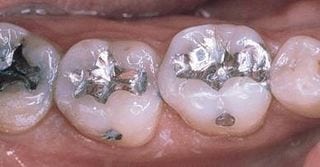An amalgam filling usually has silver, tin, and copper mixed together creating a silver filling. So when deciding what type of filling you want in your mouth there are several things to consider, such as where the filling is located and why it is needed. You and your dentist should decide together. We feel both amalgam fillings also known as silver, and Composite fillings (tooth-colored) are good options.
Dental amalgam has long been used in dentistry for filling in cavities caused by tooth decay – it has been chosen for hundreds of years due to its low cost and durability. Amalgam is produced from a mixture of liquid mercury and an alloy commonly made from silver, tin, copper, and other solid particles. This composition is used to fill in cavities, which are first cleaned by your dentist. It takes time for amalgam to harden and reach its full strength – so it is often recommended not to apply pressure or eat hard foods for the first 24 hours. After fully hardening, amalgam fillings can last from 10 to 15 years – they are known as strong and durable and are a great option for filling in decayed areas of your teeth.
The procedure for getting silver amalgam fillings is similar to the steps for composite fillings. Your dentist will first begin by using a local anesthetic to numb the affected area. Once prepped the infected tooth will need to be cleaned. Amalgam fillings usually require the dentist to remove a little bit more of the tooth to create a strong bond, resulting in a stronger restored tooth. Once the tooth has been properly filled and the filling molded, the procedure is done. Typically, amalgam fillings are a little quicker than composite fillings. Instead of a curing process, your dentist will remind you that it will take at least 24 hours for the filling to harden.
Amalgam fillings are a proven direct restoration process that is cost-effective, long lasting, and durable. One downside is they are a little more noticeable because of their silver colour. Some patients may be sensitive to the metals used, although a proper filling will not cause any toxic effects. Your dentist will be able to help you decide which filling will leave you with a happy and healthy smile.
Pros and Cons of Amalgam (silver) fillings
Pros:
- Very strong and durable
- Highly resistant to wear
- Long-lasting
- Inexpensive
- May inhibit bacterial activity around it
Cons:
- Not as cosmetically pleasing as Composites
- Transmits hot and cold readily, usually causing short-term sensitivity
- Could expand or contract over time, which could cause the tooth to crack
- May leak trace amount of mercury vapor, which has not been proven to be harmful (see below)
Many studies have been conducted worldwide showing that if amalgam is mixed properly, the mercury vapor leaking over time within the mouth is well within safe limits and has not demonstrated any health consequences. Bodily intake of mercury can often be much greater from eating fish or shellfish than from leaking amalgam.
According to major U.S. and international scientific and health organizations – including the American Dental Association, the National Institutes of Health, the Food and Drug Administration, and the World Health Organization – dental amalgam is a safe, reliable and effective restorative material.

